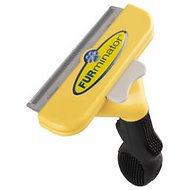Dog Grooming – Tips on How to Groom a Dog
Quick Guide
One of your responsibilities as a dog owner is to take care of your dog’s skin and coat – that means you will have to groom your dog on occasion. A dog’s grooming needs vary depending on the type of coat and its length. Some dogs can get away with a weekly brushing while others require daily brushing and regular trimming. Below you will find information about all of the various aspects of grooming a dog.
Why Grooming is Important
Grooming your dog is about more than just cleaning him up – it can be a bonding experience for the two of you as well. Some other important reasons to groom your dog include:
- Improving circulation in your dog’s skin for healthy skin and coat.
- Giving you and your dog intimate time together to improve your bond.
- Familiarizing yourself with your dog’s body so you will be more likely to notice changes that could point to a medical problem.
- Keeping your dog’s fur from forming painful mats or tangles.
- Improving your dog’s appearance, especially if you plan to show your dog.
Just as there are many reasons to groom your dog, there are many different aspects of grooming that you may need to learn. Not only do you need to brush your dog’s coat, but you may also need to bathe him, trim his coat, and clip his nails as well.
Understanding Coat Types
Different breeds of dog have different types of coats and, in order to properly groom your dog, you’ll need to know what kind of coat he has. Knowing what type of coat your dog has will help you to choose the right grooming tools and it will also help you to know how to groom your dog. Below you will find a list of coat types as well as a description of each:
- Short and Smooth – This type of coat is short in length and smooth in texture. Examples of breeds with this type of coat include hounds, Chihuahua’s, retrievers, etc.
- Short and Wiry – This type of coat is short in length and rough or bristly in texture. Examples of breeds with this type of coat include terriers like the Scottish terrier and the West Highland terrier (Westie).
- Medium – This type of coat is typically between 1 and 3 inches in length and it may be straight, wavy, or curly in texture. Examples of dogs with medium-length coats include German Shepherds, Golden Retrievers, and Border Collies.
- Long – This type of coat is typically more than 3 or 4 inches long and it may be straight, wavy, or curly in texture. Many dogs with long coats also exhibit a part down the middle of the back – examples include the Shih Tzu, Maltese, and the Yorkshire Terrier.
- Wavy – This type of coat may vary in length but the texture is curly, or wavy. This coat type tends to mat and tangle easily and examples of breeds with wavy coats include Bichon Frise, Poodles, and Portuguese Water Dogs.
- Thin or Delicate – This type of coat is made up of very fine hairs that are typically straight and smooth. Examples of dogs with thin or delicate coats include the Flat-Coated Retriever and the Afghan Hound.
Recommended Grooming Tools
In order to groom your dog you will need to have certain tools on hand. Grooming tools come in all shapes and sizes for different types and lengths of coats. Below you will find information about the most common grooming tools and the type of coat for which they are recommended:
-
Bristle Brushes – This type of brush can be used for all types of coats because they come with bristles of different length and stiffness. The longer the coat, the more widely spaced the bristles should be and the coarser the coat, the stiffer the bristles should be.
-
Wire-Pin Brushes – This type of brush is recommended for medium-length and long coats as well as coats with a curly or wavy texture. Wire-pin brushes may come with or without rubber-tipped ends.
-
Slicker Brushes – This type of brush is typically wide and rectangular with very fine wire bristles. Slicker brushes are commonly used to work through mats and tangles.
-
Undercoat Rakes – This type of brush is particularly useful for dogs with very thick coats and those with double coats having a fine undercoat. Use this tool to remove loose and dead hairs from your dog’s undercoat to help control shedding.
-
Shedding Blade – This type of tool consists of a thin piece of serrated metal bent in a loop attached to handle. Shedding blades help to remove excess hair before it can be shed and it helps to keep the coat looking glossy.
Other grooming tools you may need to use on occasion include combs, mat-breakers, de-shedding combs and other types of brushes.
Choosing the Right Tool for the Job
Now that you know the basics about the different coat types and the most commonly used grooming tools you can put the two together. Below you will find a list of coat types and recommendations for the type of grooming tools to use on that particular type of coat.
- Short and Smooth – The recommended tools for this type of coat are soft or medium bristle brushes with closely-spaced, short bristles. You may not need to brush this type of coat everyday but, when you do, brush with the grain of the coat – that is, in the direction of hair growth – working from the head, down the back toward the tail.
- Short and Wiry – The recommended tools for this type of coat are firm bristle brushes with closely-spaced, short bristles and slicker brushes. This type of coat typically sheds very little which makes it easy to maintain. When you brush this type of coat, brush with the grain of the coat working from the head to the tail.
- Wavy or Curly – The recommended tools for this type of coat are slicker brushes and wire-pin brushes. Work through any mats or tangles with the slicker brush and use the wire-pin brush to brush with the grain of the coat from head to tail.
- Medium or Long – The recommended tools for this type of coat are wire-pin brushes and soft or medium bristle brushes with medium- or widely-spaced, long bristles. Work through any mats or tangles with the slicker brush and brush the coat with the grain from head to tail.
- Thin or Delicate – The recommended tools for this type of coat are wire-pin brushes and soft slicker brushes. Use the wire pin brush to work from the head to the tail, brushing with the grain of the coat. Work through any mats or tangles with the slicker brush.
Bathing Your Dog
It is generally recommended that you brush your dog thoroughly before bathing in order to remove any dead and loose hairs. Most breeds of dog do not require frequent bathing – in fact, bathing your dog too often could cause his skin to become dry and irritated. It is generally recommended that you only bathe your dog once every few months unless he gets particularly dirty. When you do bathe your dog, be sure to use dog-safe shampoo and follow the steps listed below:
- Place a non-slip mat in the bathtub to give your dog traction. If you don’t have a non-slip mat, try using a large towel instead.
- Fill the bathtub with several inches of warm water – the amount of water in the tub may vary depending on the size of your dog but it shouldn’t come higher than a few inches above the foot.
- Thoroughly wet your dog’s coat then apply a small amount of dog-safe shampoo – do not use human shampoo because it may be too harsh for your dog’s coat.
- Work the shampoo into a lather, keeping your dog’s face and ears dry.
- Rinse out all of the shampoo, making sure to avoid getting your dog’s eyes, nose and ears wet.
- Use a towel to get as much moisture out of your dog’s coat as possible then use a hair dryer on the low heat or cool setting to completely dry the coat.
If you are bathing your dog during the summer, you may not need to dry his coat completely. In the winter, however, leaving your dog’s coat wet could make him sick.
In addition to bathing and brushing your dog, you may need to occasionally trim his fur. If you only need to trim the fur on your dog’s feet and ears, you can get away with using a pair of small, sharp shears. For an all-over trim, however, you may need to use a pair of electric clippers. If you intend to trim your dog yourself you may want to have a professional groomer do it for you a few times so you can learn how. If your dog has long, floppy ears you may want to trim the hair inside the ears to help prevent ear infections. In the winter, trimming the fur on your dog’s feet and between his toes can help to prevent matting and it will also keep snow from getting packed into your dog’s feet which can be very painful.


















Hi Carlotta, thanks for sharing these amazing grooming tips. These are some of the important tips which each and every owner should and also can groom your pet at home. Thus, these will help the owner of the dog to groom their at home and can make them more healthy. This will make the fur of your dog healthy and also saves the amount which you spend at grooming center.
Great blog and like to read more such informative blogs !!!